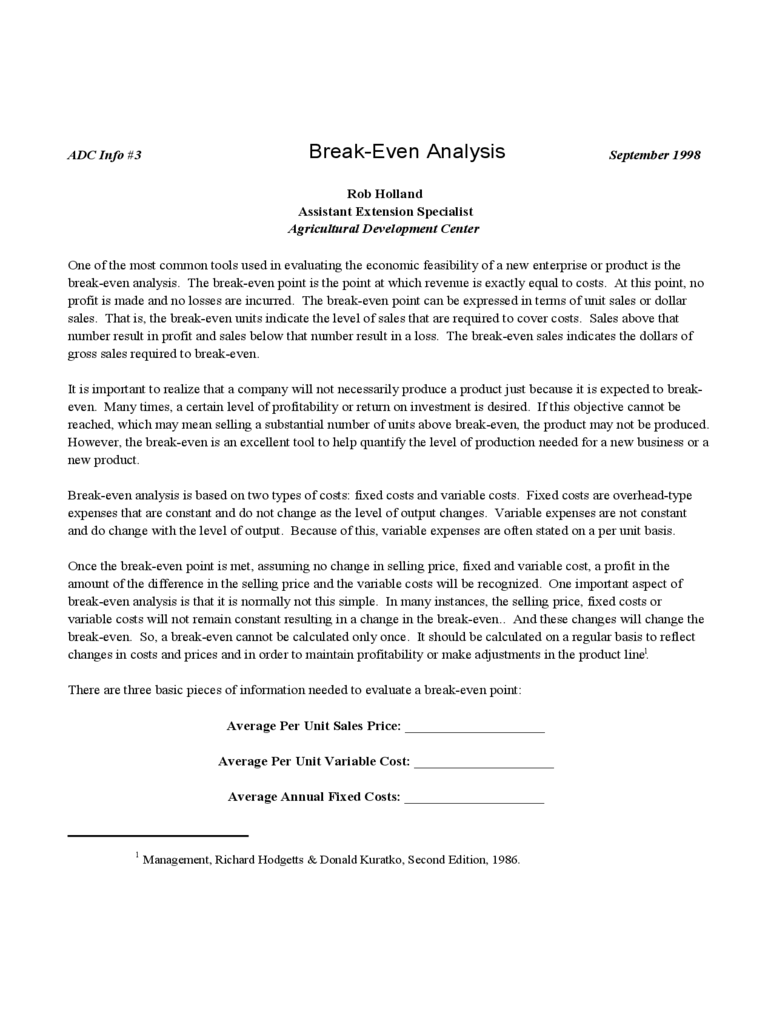Fillable Printable Break-Even Analysis Sample Template
Fillable Printable Break-Even Analysis Sample Template

Break-Even Analysis Sample Template

1
Management, Richard Hodgetts & Donald Kuratko, Second Edition, 1986.
ADC Info #3
Break-Even Analysis
September 1998
Rob Holland
Assistant Extension Specialist
Agricultural Development Center
One of the most common tools used in evaluating the economic feasibility of a new enterprise or product is the
break-even analysis. The break-even point is the point at which revenue is exactly equal to costs. At this point, no
profit is made and no losses are incurred. The break-even point can be expressed in terms of unit sales or dollar
sales. That is, the break-even units indicate the level of sales that are required to cover costs. Sales above that
number result in profit and sales below that number result in a loss. The break-even sales indicates the dollars of
gross sales required to break-even.
It is important to realize that a company will not necessarily produce a product just because it is expected to break-
even. Many times, a certain level of profitability or return on investment is desired. If this objective cannot be
reached, which may mean selling a substantial number of units above break-even, the product may not be produced.
However, the break-even is an excellent tool to help quantify the level of production needed for a new business or a
new product.
Break-even analysis is based on two types of costs: fixed costs and variable costs. Fixed costs are overhead-type
expenses that are constant and do not change as the level of output changes. Variable expenses are not constant
and do change with the level of output. Because of this, variable expenses are often stated on a per unit basis.
Once the break-even point is met, assuming no change in selling price, fixed and variable cost, a profit in the
amount of the difference in the selling price and the variable costs will be recognized. One important aspect of
break-even analysis is that it is normally not this simple. In many instances, the selling price, fixed costs or
variable costs will not remain constant resulting in a change in the break-even.. And these changes will change the
break-even. So, a break-even cannot be calculated only once. It should be calculated on a regular basis to reflect
changes in costs and prices and in order to maintain profitability or make adjustments in the product line.
1
There are three basic pieces of information needed to evaluate a break-even point:
Average Per Unit Sales Price: ____________________
Average Per Unit Variable Cost: ____________________
Average Annual Fixed Costs: ____________________

The basic equation for determining the break-even units is:
Average Annual Fixed Cost
÷
(Average Per Unit Sales Price - Average Per Unit Variable Cost)
The basic equation for determining the break-even sales:
Annual Fixed Cost
÷
1 - (Average Per Unit Variable Cost ÷ Average Per Unit Sales Price)
Break-even analysis can be very helpful in the evaluation of a new venture. In most instances, success takes time.
Many new enterprises and products actually operate at a loss (at a point below break-even) in the early stages of
development. Knowing the price or volume necessary to break-even is critical to evaluating the time-frame in
which losses are permissible. The break-even is also an excellent benchmark by which a company’s short-term
goals can be measured/tracked. Break-even analysis mandates that costs be analyzed. It also keeps a focus on the
connection between production and marketing.
Example: A local livestock producer utilizes compost waste to develop an organic fertilizer product. The fertilizer
is prepared for retail sale in 50 pound bags. The retail sales price is $5.00 per bag. The average variable cost per
bag is $2.80 and average annual fixed costs are $60,000. These three pieces of information are:
Average Per Unit Sales Price = $5.00 per bag
Average Per Unit Variable Cost = $2.80 per bag
Average Annual Fixed Costs = $60,000.00
The above assumption can be utilized to calculate the number of bags that must be sold in order to break-even as
well as the total dollar of sales needed to break-even. Using the formulas explained earlier, the following
calculations can be made:
Break-Even Units: $60,000.00 ÷ ($5.00 - $2.80) = 27,273 bags
Break-Even Sales: $60,000.00 ÷ 1 - ($2.80 ÷ $5.00) = $136,365
Therefore, no profits are made from the sale of this product until more than 27,273 bags are sold or more than
$136,365 in gross sales is generated.



